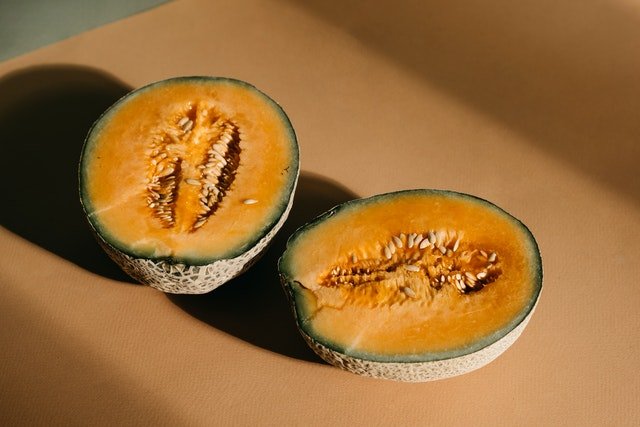
Melon seeds are usually discarded following a wrong custom: let’s find out why melon seeds can be eaten and what they are good for.
Melon seeds are a real food, but for a long time underestimated. Taking second place with respect to the fruit that contains them, and usually ending up in the waste, these seeds have, to tell the truth, some noteworthy properties, which we will describe later. There will also be advice on how to use them in the kitchen, as well as information on possible contraindications.
What happens if you eat melon seeds? Can they be eaten or are they bad?
Although treating them as food waste is a common habit, the seeds of the melon can be eaten. They are in fact edible and have interesting nutritional characteristics. 100 g of melon seeds provide about 560 kcal and contain 15 g of carbohydrates, 28 g of proteins and 47 g of fats, mostly unsaturated.
The sugars and saturated fats amount, respectively, to 0 g and 11 g. The protein fraction is composed, among other things, of important amino acids, such as glutamic acid, tryptophan and arginine. The latter favors body recomposition, in terms of fat reduction and muscle tissue increase, while glutamic acid participates in brain functions. Finally, tryptophan is an essential amino acid. The same quantity of seeds also contains 4 g of dietary fiber, useful for intestinal function. Being a vegetable food, melon seeds do not contain cholesterol.
As for micronutrients, melon seeds are rich in mineral salts, such as potassium, magnesium, zinc, selenium, and vitamins. These include vitamin A, vitamin E and the B vitamins. The contribution of beta-carotene, flavonoids and phenolic acids is also interesting.
What do melon seeds taste like?
Chewing the melon seeds returns a certain crunchiness, while their aroma vaguely refers to pumpkin seeds, with a rather crunchy texture. The characteristics of these seeds adapt to the most classic culinary uses, as we will see later.
How many melon seeds can you eat per day?
As can be seen from the nutritional information, melon seeds are a rather caloric food and characterized by an important lipid component. In order to appreciate its qualities and benefits, it is good to consume it in moderation, not exceeding 30 g per day. Eating too many melon seeds, in fact, predisposes to calorie excess. Therefore, consuming one or two slices of melon with its seeds is not a problem, on the contrary, it also gives us the nutrients present in the seeds.
Properties of melon seeds: what they are good for
By virtue of its nutritional composition, melon seeds have several beneficial properties for human health. Let’s go into more detail of each property.
✓ Analgesic and anti-inflammatory properties
Some experimental observations conducted on animal models have shown marked analgesic and anti-inflammatory properties for melon seed extracts . The effects in question, among other things, were investigated at more dosages, resulting more marked for higher dosages. Among the components involved in these activities are some phenolic acids, such as gallic and vanillic acids.
✓ Antimicrobial property
Laboratory studies carried out on some bacterial strains attribute to the essential oils extractable from melon seeds some interesting bactericidal properties. In particular, these substances seem to be activated both against the gram-negative bacteria Shigella dysenteriae, Salmonella typhimurium, and Escherichia coli, and against the gram-positive species Staphylococcus aureus, Streptococcus pyogenes and Bacillus subtilis, showing greater efficacy towards the latter.
✓ Antioxidant properties
Further experimental observations suggest that melon seed extracts may oppose oxidative stress by acting as antioxidants. In particular, it seems that they can perform a chelating (sequestering) action on some metals (copper, iron). In addition, these extracts and the related phenolic compounds act as “scavengers” towards free radicals.
✓ Properties useful for cancer prevention
Experiments conducted on cellular models starting from plant extracts of seeds, attribute to the latter some promising antiproliferative properties. In other words, the extracts showed a blocking action on the multiplication of cancer cells, probably activating the mechanisms of cell death. These effects are associated with the phenolic compounds present in the extracts.
✓ Regulating properties on the intestine
As mentioned in the introductory part, the properties of melon seeds do not exclude an effective regulating function on the intestine, thanks to the relative contribution of glutamic acid and vegetable fiber.
✓ Cardioprotective properties
Melon seeds boast a good content of unsaturated fatty acids, making them a protective food for heart health. The relative intake of potassium and magnesium makes melon seeds beneficial for blood pressure control.
How to eat melon seeds: tips for using them
Once the theoretical notions of their properties have been described, let’s now see how to eat melon seeds. In addition to being consumed as they are together with the melon pulp, the seeds, like pumpkin seeds, can be added to salads or yogurt, although they can also be consumed alone as a hunger-breaker snack.
Furthermore, melon seeds can be included among the ingredients of fruit drinks, blending them together with the melon pulp. In other cases, melon seeds can be included among the ingredients of homemade energy bars, or, once blended and pulverized (where swallowing the melon seeds as they are), among the additional ingredients of winter soups (in this case we will use the seeds of winter melons).
For a more pleasant texture and aroma, melon seeds are suitable for roasting and drying, which can be done with different methods. With the help of a knife, it is necessary, first of all, to remove the seeds from the fruit, and then wash them in running water. Once all the fruit residues have been removed, they must be dabbed with kitchen paper, drying them from the residual water.
- Toast the melon seeds: for toasting, just heat a non-stick pan over low heat and transfer the seeds inside, then turn them for a few minutes, until they are slightly darker;
- Dry the melon seeds: where you prefer to dry the melon seeds, you can spread them on a clean cloth and leave them in the sun for a few days. Alternatively, you can use the oven or the dryer, obtaining a similar result in a shorter time. In the first case, the oven temperature must be adjusted to 50 ° C and, once heated, place the pan containing the seeds in the lower shelf. At this point, it is preferable to wait 4 hours, turning the seeds every 15 – 20 minutes. After the necessary time has elapsed, it is advisable to turn off the oven, leave the door semi-open and let the seeds cool inside, before distributing them in food bags or glass jars. If you opt for the dryer, you need to set its temperature to 50 ° C, arrange the seeds inside and wait about two hours.
Melon seeds prepared in this way should be stored in food bags or glass jars with airtight closure. At this point, it is best to keep the containers in a cool and dry place. It is also possible to add a pinch of salt (to be avoided in case of high blood pressure or in a diet against water retention).
Melon seeds: the possible contraindications
As stated earlier, excessive consumption of melon seeds can be related to imbalances in calorie and lipid intake. Eating large quantities of this food could be associated, especially in predisposed subjects, with adverse effects of a gastrointestinal nature.






